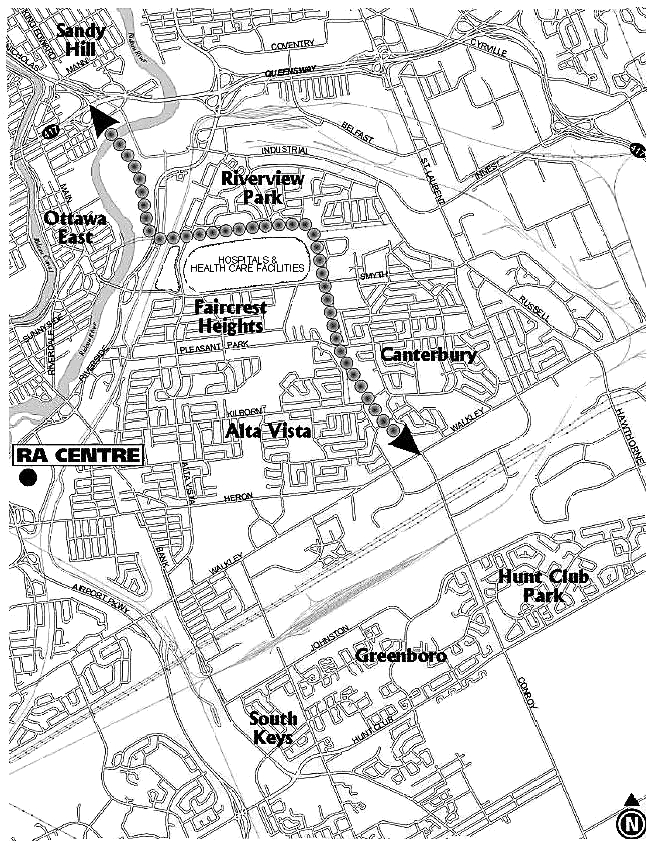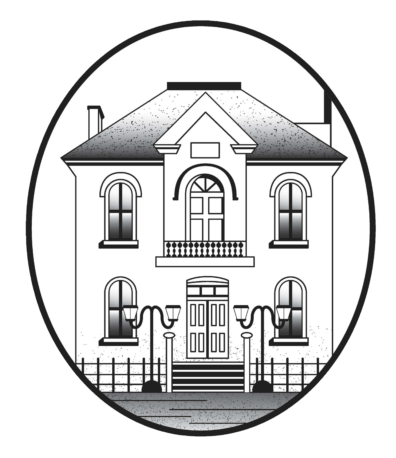Alta Vista Transportation Corridor (AVTC) historical information (2003-2007)
Note: This page contains archival information about the Alta Vista Transportation Corridor written between 2003 and 2007. Some of the information on this page may no longer be accurate.
Overview
 The Alta Vista Transportation Corridor (also known in previous times as the Alta Vista Parkway or Expressway) is a project aimed at providing transportation relief for the south east sector of the city.
The Alta Vista Transportation Corridor (also known in previous times as the Alta Vista Parkway or Expressway) is a project aimed at providing transportation relief for the south east sector of the city.
The corridor begins at Conroy and Walkley and winds through green spaces and parks in Alta Vista (behind the Ottawa Hospital’s General campus), through Hurdman Park, across the Rideau River to potentially terminate at the Queensway at the Nicholas ramp.
The corridor has been part of the City of Ottawa Official Plan since 1974. When Highway 417 was being built, this corridor was one of the proposed routes (In fact, it was the first proposed route in 1965 as part of the “South East Freeway” which included plans to turn King Edward into an expressway through Sandy Hill and Lowertown).
In 1994, an environmental assessment (EA) study was conducted to identify potential transportation demands to and from the southeast sector. This EA study served as the basis for the Transportation Master Plan of 1997.
The city selected Delcan as contractor to do the environmental assessment for the Alta Vista Transportation Corridor. The assessment is supposed to review alternatives and recommend the “best” one. Selection of the contractor took place in the summer of 2001. Delcan is responsible to organize the public consultation for the City which began in the fall of 2001. Click here to see the process being followed.
Experience has taught us that there are some traffic planners who only think of highway building. Theirs is a world view forged in the 50’s when more cars on the road was equated with progress. Over the years, two of their favourite tactics to get public opinion on side for building highways inside a city are to promise it will lower traffic on regular streets (even if in practice it never has) and to pit one neighbourhood against another.
Reduced traffic on Alta Vista, Bank and Main has been claimed if this is a highway. The community associations in the downtown area are united against this claim because we’ve heard it before (most recently for the Bronson/Airport Parkway expansions) and we seen it to be false (see APETIS report for more details). Some of the folks in Alta Vista strongly want the corridor to be a highway because they want less traffic and so far they believe the story and don’t realize it will have the opposite effect.
Nobody wants more traffic in their neighbourhood
Most of you reading this don’t think we need more traffic on residential streets. The real question is: when has building a highway inside a city ever done anything but increase traffic in the neighbourhoods it traverses and how does this potential roadway project compare?
The big problem with this roadway if it is meant for automobile traffic is that the end point at the Nicholas on ramp of the Queensway is already saturated with traffic. There is no place for the traffic to go. The new highway will be backed up and clogged. This means drivers will take every opportunity to get off and cut around the traffic jam which will mean more traffic on Riverside, Alta Vista, Smyth, Bank, Main, Lees, Greenfield, King Edward and through the neighbourhoods.
The city’s previous official plan was supposed to give priority, in order, to pedestrian, bicycle, mass transit and automobile traffic. It was also supposed to be doing something to reduce greenhouse gases. In practice, these things have yet to be done in anything other than a token basis. Green house gas emissions have risen 43% since 1996! The city’s 2020 Summit in the was meant to kick off Smart Growth to plan for the next 20 years. Since the 2020 Summit, the city has increased road capacity while it has cut back on transit and either cut or delayed funds to cycling and pedestrian projects. This project is an opportunity for traffic planners to “walk the talk” for a change.
Alternatives
This section compares the pros and cons of the City’s preferred road alternative and Citizens for Healthy Communities preferred transit alternatives.
The need is presumed to be primarily for commuters living in bedroom communities south and east of the airport to get to and from work in downtown (about 1800 person-trips per hour). A secondary need is to improve access to the Ottawa Hospital’s General Campus on Smyth.
This Environmental Assessment (EA) was supposed to consider alternatives for the Alta Vista Corridor and recommend a preferred solution. Options which were supposed to be considered were a roadway, a roadway with transit and transit only, all of which were to be considered with alternate routes. All of these alternatives were supposed to be considered together taking into account public and technical input including air quality and health consequences.
The Public Advisory Committee (PAC), Technical Advisory Committee (TAC) and consultant filled out detailed ranking of priorities as part of the “concordance method” in 2003, which was supposed to be used to evaluate all the alternatives. City staff condoned and supported the consultant’s evaluation including not voting a higher priority to transit-based mobility compared to road-based mobility as well as flawed analysis which claimed a road solution would yield less pollution than transit.
The City’s Preference: a Roadway in the Corridor
Using the concordance method to compare alternatives, the consultant under the City’s guidance scored a 4-lane road as the theoretical best solution to meet the need of 1800 commuters per hour from the southeast. The 4-lane road which they choose has the following theoretical attributes:
- 2-lanes for motor vehicles (including trucks),
- 2-lanes for high occupancy vehicles (HOV), (including buses),
- runs from Conroy to Nicholas,
- intersections at Walkley, Kilborn, Pleasant Park, Smyth, Alta Vista and Riverside,
- interchange ramps added at the Queensway at Nicholas to allow access.
Since a roadway won the theoretical exercise, design is proceeding to see what can be built. In practice it is now clear that a 4-lane road from their concordance evaluation cannot meet one of the original need of 1800 person trips. For instance, the northern end will only carry 800 cars per hour at best in the morning. The 1000 person-trips per hour discrepancy is not a serious concern for the design team. City staff believe any road is better than transit and always better than nothing.
City staff’s unshakeable faith in car-centric solutions is evident since they have no intention of going back to see how the road they are designing in practice would have scored in the concordance method or how the air quality will be as a result. The limitations of the road they are designing begs the questions: how hard, how much more cheaply (and how much more reliably in the case of light rail) could transit get 1800 people/hour from the Southeast to downtown? This EA has not answered those questions.
Proposed city corridor roadway (dated 2005)
Maps and descriptions of the City’s current proposed corridor roadway can be found by clicking on the link or maps below. These designs were shared with the PAC on April 22, 2005:
See overall plan for a four lane road extending Conroy to Nicholas with at grade intersections on all major cross streets in the corridor.
Map of corridor road
Detailed design plans including examples of intersection designs
- Nicholas/Lees Section – northern end from the 417 interchange to the bridge over the Rideau River.
- Riverside Section – from the Rideau River to Alta Vista Drive.
- Central Section – from Alta Vista to Smyth with access to the Hospital.
- Southern Section – from Conroy/Walkley to Smyth crossing Kilborn and Pleasant Park.
- Example of intersection design for cross streets.
What’s wrong with the way they chose their alternative?
The alternative they are designing in practice doesn’t match the capacity of the alternative they claimed was the best solution in theory. The HOV lanes also have nowhere to go (province has ruled out HOV lanes on the Queensway).
They haven’t accounted for induced traffic so their traffic increase estimates are too low for road expansion alternatives. From the APETIS report of 1999 we’ve seen errors in forecast traffic increases of as much as 50% when induced traffic is ignored.
- They have not done state-of-the-art air quality projections and associated health impacts.
- They have a double standard and a bias with respect to cars versus transit:
- They didn’t evaluate transit only options in the same way they evaluated road options as they were told to do by Transportation and Transit Committee.
- City staff condoned the consultant not giving more weight in their votes to transit compared to car based mobility in the “concordance” method.
- They investigated 27 combinations of road widenings outside the corridor but they said they could not look at transit alternatives outside the corridor. The message: if it’s road based they’re willing to explore it and if it’s transit based they aren’t.
What’s wrong with their preferred alternative?
- A roadway will make traffic much worse on the Queenway, Nicholas, Lees, Riverside, Main and Alta Vista in the morning rush hour. The proposed corridor road will get traffic from the south to the traffic jam at the north end faster aggravating the northern bottlenecks.
- A roadway will make air quality (pollution and green house gas emissions) worse.
- Clogged roadways are very bad for air quality.
- A roadway will cost more than $135 million dollars (that is more than 4 times what it cost to put the O-train in service).
- As of April 2004, the Ministry of Transportation of Ontario officially recognized that expanding the 417 in the downtown section from Metcalfe to Island Park is not feasible. The Queensway will not accommodate traffic from an Alta Vista Corridor road.
Citizens for Healthy Communities (CHC): Transit-centric alternatives
There are two alternatives to consider; a short-term alternative for the hospital campus, a longer term alternative for south-east commuters.
Short-term alternative
Aerial photo with bus spine
CHC want rapid transit access to the Ottawa Hospital’s General Campus in place before road expansions. A 1.5 km bus spine road from the transitway into the hospital campus would provide more direct transit and emergency vehicle access.
Long-term alternative
Map with corridor surrounded by proposed transit routes
CHC want to see the rapid transit solutions serving the south and east sectors proposed in the city’s Transportation Master Plan implemented before any decision on any major road expansion projects proceed.
These transit alternatives would only use a small portion of the Alta Vista corridor. The rest of the Alta Vista corridor would remain as park, green-space, cycling paths and allotment gardens.
The city’s transportation priorities are supposed to favour walking first, cycling second, transit third and single occupancy vehicles last. Cyclists and pedestrians can use transit. CHC wants to see the top priorities be treated as real priorities by getting most of the funding and getting the funding first.
